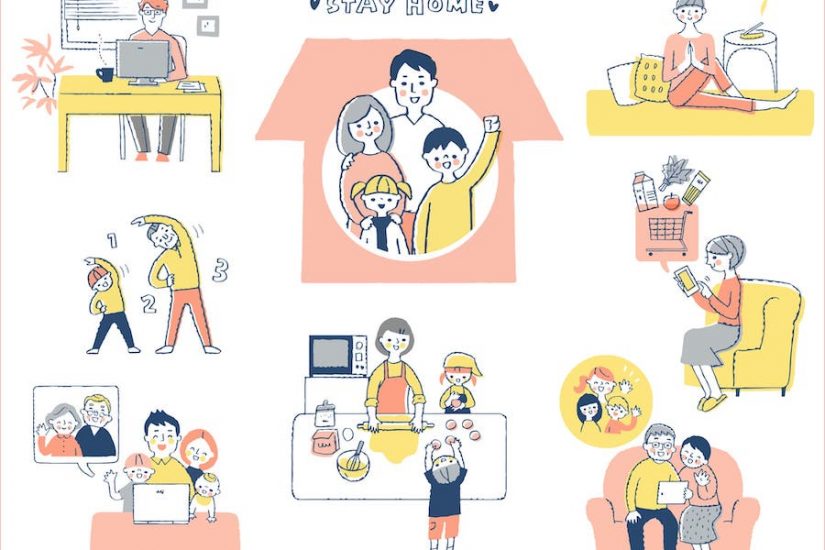How COVID-19 changed the way we work
To prevent the spread of the novel coronavirus COVID-19, people are being asked to avoid going out as much as possible. For this reason, many companies that previously required their employees to commute to an office, have now permitted telecommuting and have hurriedly established remote working systems. Once recognized, the merits of this new experience of remote working and video conferencing are bound to start a trend of re-examining working practices.
Such changes have also occurred in family life. Just as companies have developed remote working practices by utilizing the Internet, cloud services, and video conferencing services such as ZOOM, various technologies are supporting new family lifestyle changes for the post-coronavirus era which are dubbed the “new normal”.
Toward an era of online homecoming
In Japan, there is a custom called kisei (帰省) or “homecoming” during which families visit parents who live far away during long vacations such as summer vacation or the year-end and New Year holidays. To explain it in straightforward English, we can say it is a reunion simply for one’s relatives.
The long annual holidays at the end of April and the beginning of May are called “Golden Week,“ but this year’s measures against COVID-19 made travel difficult, and many people gave up on returning home. However, the concept of „online homecoming“ provided a partial solution. Many families used video conferencing services such as ZOOM to connect their household to their parents’ home, to chat with them, and to let them see their grandchildren’s faces.
According to the survey results of chikaku Inc. just under 40% of those families who had planned to return home during Golden Week actually had an online homecoming. On top of that, many respondents identified the advantages of online homecoming, saying that they enjoyed it, and that it saved both on time and expense. There were some, however, who identified negative points such as the difficulty of teaching their parents how to set up their computer or smartphone, or the difficulty of buying the necessary equipment and maintaining the system .
As online homecoming becomes more popular, and there is an increasing demand in households with only elderly people who are not comfortable with ICT, there may well soon be products that can start a video conference simply by turning them on. If that happens, the Japanese custom of homecoming may be completely transformed.
Checking the well-being of distant family members with an IoT light
Although you may be worried about the health of elderly parents who live on their own, checking their well-being by telephone or mail takes time. Video conferencing, like the online homecoming mentioned above, is difficult to do every day, and you may forget to check. Could there not be a superior method of confirming the safety of one’s parents automatically?
One such specialized means of daily safety checks which looks useful is Yamato Transport’s remote monitoring service. Yamato Transport have begun experimenting with an IoT-compatible LED light bulb called HelloLight.
HelloLight is an LED light bulb equipped with a SIM card. Although it can be fitted in a regular light socket and used for lighting, it can also transmit to other locations information on when the light is switched on and off.
So, if you fit a HelloLight in the home of an elderly parent who lives alone, you can know whether or not they are using their lighting. If they are not away from home on a trip, but they are not using their lighting, then there is a chance they may have been immobilized by injury or illness, and so you can contact their neighbors, other relatives, or the relevant medical institutions to ask for help.
Because this system employs LPWA rather than Wi-Fi, it can be easily introduced to people who are unfamiliar with ICT. Even in homes that are not connected to the internet, all you have to do is screw the bulb into a socket and you are all set. Of course, there is no need for extra wiring as all the power needed is supplied via the light socket. Just replace the existing light bulb, and you can get started right away.
ICT use rapidly progresses with the COVID-19 pandemic
Another new custom that has arisen is that of the online party whereby friends who cannot meet physically during a stay-at-home period can still mingle via a video conferencing service. As ZOOM is often used for these events, they are often called ZOOM parties. Also, an increasing number of companies are providing live streaming Internet services for weddings and funerals so attendees can take their seats online.
COVID-19 has brought many business and consumer activities to a halt. On the other hand, it has increased the number of people who use video conferencing services and made it easier to communicate via the Internet with people who are difficult to meet directly. It could be said that ICT use in Japan has made rapid progress since the COVID-19 pandemic.








